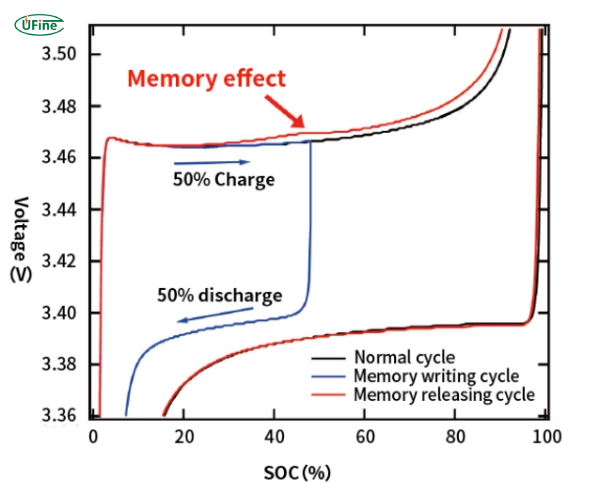Do Lithium Batteries Have Memory? The Short Answer
No, lithium-ion batteries do not have a true memory effect like nickel-based batteries. However, improper charging habits can cause similar symptoms:
- 🔋 Partial charging cycles may lead to “voltage depression,” mimicking memory effect.
- 🌡️ High temperatures accelerate capacity loss.
- ⚡ Frequent shallow discharges reduce usable capacity over time.
Part 1. Understanding the battery memory effect: causes and myths
When searching “do lithium batteries have memory“, most users are surprised to learn that modern lithium-ion batteries don’t suffer from the true memory effect seen in older nickel-cadmium (NiCd) batteries. However, the lithium battery memory effect myth persists due to similar symptoms caused by improper charging. Here’s the truth:
- 🔋 Lithium vs NiCd battery memory: NiCd forms crystals during partial charging, while lithium-ion degrades through voltage depression.
- ⚡ Partial discharges create “digital memory” in battery controllers, not chemical changes.
- 🌡️ High temperatures accelerate capacity loss, often mistaken for memory effect.
Differences Between Battery Memory Effect and Other Issues
Charge Retention:
Unlike other battery issues, such as self-discharge or voltage depression, which can also lead to reduced capacity, the memory effect relates explicitly to the battery’s ability to retain charge. While self-discharge causes batteries to lose charge over time, the memory effect alters the perceived capacity based on previous charging patterns.
Charging Patterns:
One distinguishing factor of the memory effect is its dependence on charging patterns. Typically, batteries experiencing this effect show reduced capacity when repeatedly charged after only partial discharge. In contrast, other issues like self-discharge occur regardless of the charging pattern.
Reversible Nature:
The memory effect is often reversible through conditioning, which involves fully discharging and recharging the battery several times. This helps reset the battery’s memory and restore its total capacity. In contrast, other battery issues may be irreversible or require specialized treatment for mitigation.
Chemical Mechanisms:
The memory effect primarily arises from changes in the chemical composition of the battery’s electrodes, specifically the crystalline structure of certain materials like cadmium in NiCd batteries. Other issues, such as self-discharge or voltage depression, may stem from different chemical processes or external factors like temperature or storage conditions.
Example: A NiCd battery used in cordless drills may hold less charge over time if frequently recharged before fully depleting. This results in reduced runtime and efficiency.
Part 2. Why lithium batteries don’t have true memory effect? (And what causes similar issues)
Understanding Lithium-Ion Battery Memory Effect:
The memory effect in lithium-ion batteries is less common than in older battery chemistries like nickel-cadmium (NiCd). However, it can still affect the performance of lithium-ion batteries under certain conditions. Unlike NiCd batteries, which exhibit an apparent memory effect due to crystalline formation, lithium-ion batteries primarily experience capacity degradation over time rather than a distinct memory effect.
Artikel Terkait: How to Charge a Lithium-ion Battery?
Causes of Lithium-Ion Battery Memory Effect:
Incomplete Charging or Discharging:
Lithium-ion batteries may develop a memory effect-like behavior if you repeatedly charge or discharge them incompletely. This can cause the battery to “remember” the reduced capacity and exhibit diminished performance over subsequent charge cycles.
High Operating Temperatures:
Exposure to high temperatures during charging or discharging can accelerate the battery’s chemical reactions, leading to electrode material degradation and potential memory effect-like symptoms.
Overcharging or Overdischarging:
Subjecting lithium-ion batteries to overcharging or over-discharging can also contribute to capacity loss over time. While modern battery management systems help mitigate these risks, prolonged exposure to extreme conditions can still impact battery performance.
Mitigation Strategies for Lithium-Ion Battery Memory Effect:
Proper Charging Practices:
To prevent memory effect-like behavior in lithium-ion batteries, following proper charging practices, including allowing the battery to complete full charge and discharge cycles periodically, is essential.
Avoiding Extreme Temperatures:
Minimizing exposure to high temperatures during charging and discharging can help preserve the integrity of lithium-ion battery cells and reduce the risk of capacity degradation.
Regular Maintenance:
Periodically cycling the battery through full charge and discharge cycles, commonly called battery conditioning, can help recalibrate the battery’s capacity and mitigate any memory effect-like symptoms.
| Battery Type | True Memory Effect? | Common Misconceptions |
|---|---|---|
| Lithium-ion | ❌ No | Voltage depression from partial cycles |
| NiCd | ✅ Yes | Crystalline formation |
Part 3. Memory effect in other batteries: Why lithium stands out
- Nickel-Cadmium (NiCd)
- 🔋 Severe memory effect: Requires full discharge weekly
- ⚡ Loses 15-20% capacity/month if partially charged
- Nickel-Metal Hydride (NiMH)
- 🔋 Moderate memory effect
- ⚡ Needs monthly full discharge
- Lead-Acid (Car Batteries)
- 🔋 Sulfation mimics memory effect
- ⚡ Requires equalization charging
- Lithium-ion (Modern Devices)
- ✅ No true memory effect
- ⚠️ Voltage depression from shallow cycles
- 🔥 Heat damage often confused with memory
Part 4. How do memory effects affect battery performance over time?
Reduced Capacity:
Memory effects cause batteries to hold less charge over time. When a battery “remembers” a shorter charging cycle, it won’t use its total capacity. This means you will need to recharge the battery more often, which can be inconvenient and reduce lifespan.
Shortened Usage Time:
With reduced capacity, the time a battery can power a device before recharging gets shorter. For example, a phone or laptop with a battery affected by the memory effect will run out of power faster than when the battery was new.
Increased Charging Frequency:
Due to the reduced capacity and shorter usage time, you’ll need to charge the battery more frequently. This can be frustrating and puts more strain on the battery, potentially accelerating its wear and tear.
Lower Efficiency:
Batteries with memory effect become less efficient. They may take longer to charge and discharge faster. This inefficiency can lead to higher energy costs and more frequent interruptions to charge devices.
Potential Overheating:
Repeated charging cycles and reduced efficiency can cause batteries to overheat. Overheating can damage the battery and the device it’s powering. It’s essential to monitor and manage battery temperature to avoid these risks.
Figure 1: Memory effect comparison across battery types
| Battery Type | Prone to Memory Effect | Severity | Mitigation |
|---|---|---|---|
| Nickel-Cadmium (NiCd) | Yes | High | Full discharge and recharge cycles |
| Nickel-Metal Hydride (NiMH) | Yes | Moderate | Occasional full discharge |
| Lithium-Ion (Li-Ion) | Rare | Low | Proper charging habits |
| Lead-Acid | Yes | Low | Equalizing charges |
| Alkaline | No | None | Not applicable |
Part 5. How to maximize lithium battery lifespan? (8 Proven Tips)
- Charge Smart: Keep between 20%-80% for daily use (full 0-100% cycles monthly)
- Temperature Control: Avoid charging above 35°C/95°F or below 0°C/32°F
- Use Original Chargers: Fast chargers generate more heat, accelerating degradation
- Storage Protocol: Store at 50% charge in cool environment if unused >1 month
- Calibrate Monthly: Full discharge-charge cycle resets battery controller memory
- Avoid Deep Discharges: Never drain below 5% except during calibration
- Update Firmware: Device manufacturers optimize charging algorithms via updates
- Monitor Health: Use battery health apps (iOS/Android) to track capacity loss
Part 6. How can the memory effect of batteries be prevented?
Fully Discharge and Recharge:
Occasionally, let your battery fully discharge to prevent the memory effect before recharging it. This practice helps maintain its total capacity. For example, let your phone or laptop run until the battery is nearly empty, then charge it to 100%.
Avoid Partial Charges:
Try to avoid charging your battery when it’s only partially used. Consistent partial charging can cause the battery to “remember” the shorter cycle. Instead, please wait until the battery level is lower before plugging it in.
Use Proper Charging Equipment:
Always use the charger that came with your device or a high-quality replacement. Using the correct charger ensures that your battery charges correctly and efficiently, which helps prevent memory effects and other issues.
Maintain Optimal Temperature:
Batteries perform best at moderate temperatures. Extreme heat or cold can damage them and lead to capacity loss. Keep your devices in a cool, dry place and avoid leaving them in hot cars or direct sunlight.
Regularly Calibrate Your Battery:
Calibrating your battery involves fully discharging and then fully charging it once a month. This helps the battery maintain an accurate reading of its charge level and can prevent the memory effect.
Follow Manufacturer Guidelines:
Always follow the manufacturer’s recommendations for charging and maintaining your battery. These guidelines help you get the most out of your battery and avoid issues like the memory effect.
Use Battery Management Tools:
Many devices have built-in battery management tools that can help optimise charging cycles and prevent memory effects. Check your device settings for options to manage battery health and follow the suggested practices.
Part 7. Final thoughts
In conclusion, taking proactive steps can help extend the life of lithium-ion batteries. It is crucial to understand the memory effect and how it differs from other battery issues. By practising proper charging habits and maintenance, such as full discharging and avoiding partial charges, you can minimise the impact of memory effects and keep your batteries performing optimally for longer.
Part 8. FAQs about battery memory
Do lithium batteries need full discharge to prevent memory?
No. Unlike NiCd batteries, lithium-ion doesn’t require full discharges. However, monthly calibration (full cycle) helps maintain accurate capacity readings.
Can memory effect damage lithium batteries permanently?
True memory effect doesn’t exist in lithium batteries. However, repeated shallow cycles causing voltage depression may lead to 10-15% irreversible capacity loss over 2 years.
How to fix lithium battery pseudo memory effect?
Perform battery calibration: 1) Drain to 5%, 2) Charge to 100% uninterrupted, 3) Repeat monthly. This resets the battery management system’s memory.
Does wireless charging cause memory effect in lithium batteries?
No, but wireless charging generates more heat. Sustained temperatures above 40°C (104°F) can accelerate degradation similar to memory effect symptoms.
Are electric car batteries affected by memory effect?
EV lithium batteries use advanced management systems. Tesla recommends keeping charge between 20%-90% for daily use, similar to smartphone best practices.
Do lithium AA batteries have memory effect?
No. All lithium batteries (including AA/AAA) use lithium-ion or lithium-iron chemistry that’s immune to true memory effect.
Related Tags:
More Articles

Small LiFePO4 Batteries for Solar Garden Lights: What to Look For
Learn why small LiFePO4 batteries are ideal for solar garden lights with tips on features, benefits, and how to choose the best one.
How to Choose the Right Small LiFePO4 Battery: Capacity, Dimensions, and Price
Learn how to choose the right small LiFePO4 battery by comparing capacity, size, and price for solar, RVs, scooters, and backup power needs.
Laptop Battery Replacement Guide – How to Choose Safely
Need a new laptop battery? Learn when to replace it, how to choose the right one, and where to buy safe replacements. Tips included!
What Is the Smallest 12V Battery? A Comparison of Mini Lithium Options
Discover the smallest 12V lithium batteries with top picks, comparisons, and tips for compact, powerful, and reliable energy solutions.
Current Draw and Discharge Rates: Optimizing Amped Lithium Battery Performance
Optimize Amped lithium battery life by managing current draw and discharge rates for better performance, faster charging, and longer lifespan.




